
Chiang Mai, a compelling city in northern Thailand, combines culture, history, and gastronomic pleasures. Chiang Mai is well-known for its distinct cuisine, with a variety of traditional delicacies that are a must-try for every foodie. Chiang Mai, the historic capital of the autonomous Lanna Kingdom, has kept its distinct culinary tradition, which has been influenced by Lao, Burmese, and Yunnanese Chinese cultures.
Exploring the bustling city’s local markets and eateries is a gourmet excursion that will tempt your taste senses. Let’s explore the world of Chiang Mai’s iconic cuisine, which are an important component of the city’s cultural fabric.
1. Khao Soi
Khao Soi, a thick and fragrant curry noodle soup, is a must-try in Chiang Mai. This traditional Lanna dish consists of flat egg noodles tossed in a coconut-based curry with a variety of meat, shallots, pickled cabbage, and chilies. The dish’s history is a mash-up of cultural elements, with Lao khao soi, Burmese ohn no khao swe, and Malaysian laksa serving as inspiration.
Chinese Muslims from Yunnan Province are credited with incorporating egg noodles and coconut curries. To experience the true flavor of Khao Soi, go to places like Khao Soi Khun Yai, where this legendary meal takes center stage.

2. Sai Oua
The perfect blend of native spices in Sai Oua, a beloved sausage in northern Thailand, tantalizes the palette. This pig sausage, which translates to “stuffed intestines,” is a symphony of tastes, with ingredients like kaffir lime leaves, galangal, lemongrass, and red curry paste.
Each sai oua vendor guards a different recipe, resulting in a wide variety of sausage varieties. Sai oua, when grilled and served with sticky rice, captures the essence of Northern Thai cuisine. Visit Siri-Wattana (Tha-Nin) Market for an authentic sai oua experience.

3. Lanna-style Larb
Lanna-style Larb is a radical take on the traditional meat-based salad. The Lanna variant, unlike the Lao version, has a scorching kick. Stir-fried chopped meat, usually pork, beef, duck, or fish, is combined with pork blood cubes, offal, and an assortment of herbs and spices in this salad.
Cloves, cumin, and long pepper add to the dish’s particular flavor profile. Larb kua, for example, omits the pork blood cubes, while others use raw flesh. Huen Phen is a recommended eatery to try this vivid and spicy creation.
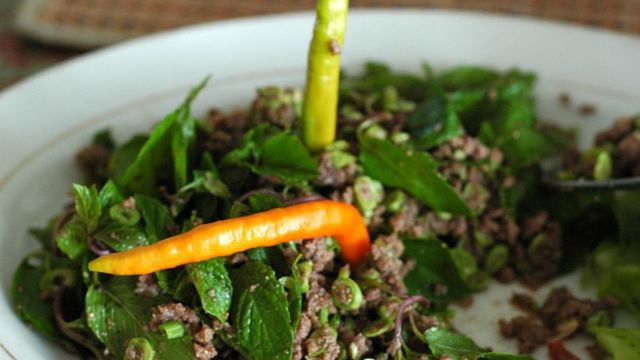
4. Gai Yang
Gai Yang, a delicious grilled chicken dish, highlights indigenous ingredients and flavors. The chicken is grilled to perfection after being marinated with lemongrass, garlic, soy sauce, and fish sauce. Gai Yang presents a symphony of flavors, accompanied by dipping sauces, som tam (green papaya salad), and sticky rice.
Each restaurant in Chiang Mai puts its own spin to the dipping sauce, encouraging diners to sample a variety of flavors. Gai Yang Cherng Doi is a good place to enjoy this grilled masterpiece.
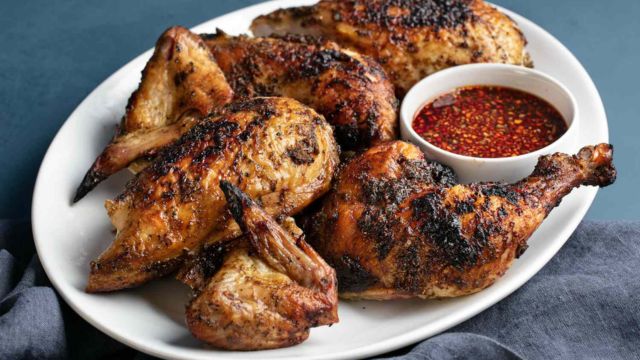
5. Panang Curry—Phanaeng
Panang Curry, also known as Phanaeng in Thailand, is a popular Thai curry dish recognized for its delicate balance of sweetness and saltiness. Peanuts, salt, shrimp paste, shallots, chili peppers, galangal, lemongrass, and other aromatic spices are included in the curry paste.
This tasty dish, served with beef or chicken, has a gentler spice level, making it an acceptable option for people new to Thai food. Panang Curry can be enjoyed at a variety of restaurants across Chiang Mai.
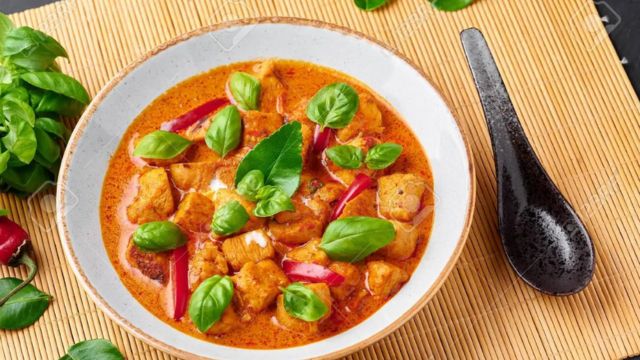
6. Red Beef Curry—Kaeng Phet
Kaeng Phet, also known as Red Beef Curry, is a flavor-packed Thai culinary staple. Kaeng Phet uses ingredients similar to Panang Curry but adds dry red spur chilies for a bite. This curry can be made with a variety of proteins, including beef, chicken, pork, shrimp, or duck.
Vegetarians can substitute tofu or savory vegetables, but keep in mind that most red curry pastes contain shrimp sauce. The intense flavors and spice levels of Kaeng Phet make it a favorite among both residents and foreigners.
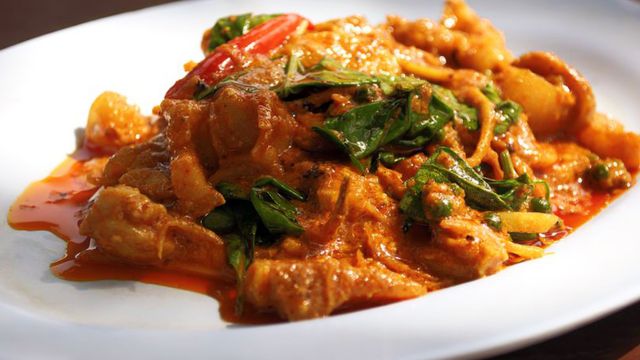
7. Green Curry—Kaeng Khiao Wan
Green Curry, or Kaeng Khiao Wan, is a tantalizing Thai cuisine known for its sweet and fragrant flavor profile. This curry has a distinct flavor profile thanks to the use of coconut milk, chiles, fresh cilantro, and basil. The dish is distinguished by its significantly sweeter flavor when compared to other Thai curries.
Green Curry, served with roti or rice, is an unexpected gastronomic excursion for people seeking vivid flavors. Don’t pass up the chance to sample this delectable delicacy while exploring Chiang Mai.

8. Massaman Curry—Kaeng Matsaman
Massaman Curry, also known as Kaeng Matsaman, is a wonderful blend of spices that incorporates elements from both southern Thai and Indian cuisine. Massaman Curry, infused with cinnamon and cardamom, provides an aromatic and slightly Indian-inspired taste.
This curry, which is traditionally served with chicken or other protein options, is a tribute to Thailand’s rich culinary history. Despite being less well-known than its red and green siblings, Massaman Curry is a truly hidden treasure that should not be neglected.
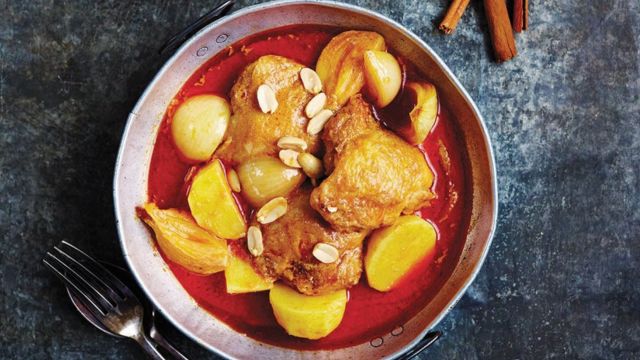
9. Khan Tok Platter-Khan Tok
Khan Tok Platter is a Northern Thai appetizer platter with grilled meats, skewered veggies, and a selection of salads. It’s an excellent chance to sample a range of Northern Thai foods. Grilled meats are often marinated in a spice blend and include chicken, hog, or beef. Onions, tomatoes, and mushrooms are frequently skewered and roasted until soft.
Salads are often made with shredded cabbage, carrots, and green onions and tossed in a tangy vinaigrette. In Chiang Mai, the Khan Tok Platter is a wonderful and refreshing way to start your meal.
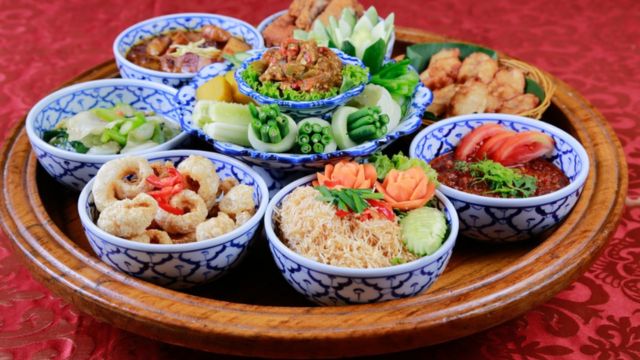
10. Miang Kham
Miang Kham is a Northern Thai snack composed with ingredients such as chilies, lime, shallots, roasted peanuts, and dried shrimp. The contents are wrapped in betel leaves and consumed whole. Miang Kham is a spicy drink that is also quite refreshing. The word “miang kham” means “one bite wrap” in Thai.
The ingredients are wrapped in betel leaf because it has a somewhat bitter flavor that serves to balance out the sweetness of the lime and the spiciness of the chilies. The salty and savory flavor of the peanuts and dried shrimp is balanced by the crunch of the shallots.
Conclusion
The gastronomic scene of Chiang Mai reflects the city’s diverse history and cultural influences. As you walk around this northern Thai city’s bustling marketplaces and delightful eateries, you’ll come across a tapestry of flavors that reflect centuries of history and creativity. Each dish, from the renowned Khao Soi to the delicious sai oua, tells a tale about Chiang Mai’s unique culinary legacy. So, I hope you have a wonderful stay in Chiang Mai and get to eat some of these delectable delicacies.



